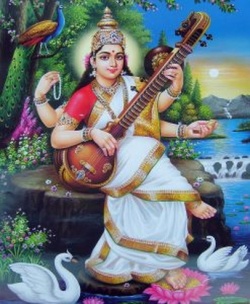Saraswati - The Teacher
The Teacher
THE DEVI OF KNOWLEDGESaraswati is the Goddess of leaming, knowledge, and wisdom. The Sanskrit word sara means “essence” and swa means “self.” Thus Saraswati means “the essence of the self.”.
Saraswati is represented in Hindu mythology as the divine consort of Lord Brahma, the Creator of the universe. Since knowledge is necessary for creation, Saraswati symbolizes the creative power of Brahma. Goddess Saraswati is worshipped by all persons interested in knowledge, especially students, teachers, scholars, and scientists. ancillary Vedic literature consistently equates her with the goddess of speech, known as Vak. The importance of speech in Hinduism is both ancient and central. The entire creative process is said to be held in the sacred syllable OM, and the idea of creation proceeding from shabda –brahman (ultimate reality in the form of sound) is often mentioned in the ancient texts. A mantra too, which may consist of words or of sounds alone, is said to possess great power. Indeed, the mantra of a given deity is declared to be equivalent to the deity itself. To pronounce a mantra is to make the deity present. There resides in sound a potent quality, and this quality is embodied in Saraswati, the Goddess of speech. As the embodiment of speech, then, Saraswati is present wherever speech exists. And so it is that she is pre-eminently associated with the best in human culture: poetry, literature, sacred rituals, and rational communication between individuals.
Till today, whenever a new baby arrives, grandmothers make a five pointed star-called Saraswati-sign on the newborn’s tongue with honey. The tongue, the organ of speech, is thus expected to get hitched to Saraswati’s star early enough.
In Her popular images and pictures, Goddess Saraswati is generally depicted with four arms (some pictures may show only two arms), wearing a white sari and seated on a white lotus. She holds a book and a rosary in Her rear two hands, while the front two hands are engaged in the playing of a lute (veena). Her right leg is shown slightly pushing against Her left leg. She uses a swan as Her vehicle. There is a peacock by Her side gazing at Her. This symbolism illustrates the following spiritual ideas:
Her Message:
She focuses her calm, dispassionate gaze upon the past as pure experience. The capacity to recall without anger or resentment, is Saraswati’s greatest gift to her children: the writers, musicians and creators of various art forms. All of them have fought with tradition, but their fight has been cerebral, not emotional. For without cutting away the umbilical cord, no innovative new beginning may ever be made, whether one is creating or procreating. This is the message of Saraswati.
Her Lotus:* The lotus is a symbol of the Supreme Reality, and a white lotus also denotes supreme knowledge. By sitting on a lotus, Saraswati signifies that She is Herself rooted in the Supreme Reality, and symbolizes supreme knowledge. The white color symbolizes purity and knowledge. The white sari that the Goddess is wearing denotes that She is the embodiment of pure knowledge.
Her Arms:* The four amms denote Her omnipresence and omnipotence. The two front amms indicate Her activity in the physical world and the two back arms signify Her presence in the spiritual world. The four hands represent the four elements of the inner personality. The mind (manas) is represented by the front right hand, the intellect (buddhi) by the front left hand, the conditioned consciousness (chitta) by the rear left hand, and the ego (ahankara) by the rear right hand.
- The left side of the body symbolizes the qualities of the heart and the right side symbolizes activities of the mind and intellect. A book in the rear left hand signifies that knowledge acquired must be used with love and kindness to promote prosperity of mankind.
- The rosary signifies concentration, meditation, and contemplation, leading to samadhi, or union with God. A rosary in the rear right hand representing ego conveys that true knowledge acquired with love and devotion melts the ego and results in liberation (moksha) of the seeker from the bondage to the physical world.
- The Goddess is shown playing a musical instrument that is held in Her front hands, which denote mind and intellect. This symbol conveys that the seeker must tune his mind and intellect in order to live in perfect harmony with the world. Such harmonious living enables the individual to utilize acquired knowledge for the welfare of all mankind.
- Two swans are depicted on the left side of the Goddess. A swan is said to have a sensitive beak that enables it to distinguish pure milk from a mixture of milk and water. A swan, therefore, symbolizes the power of discrimination, or the ability to discriminate between right and wrong or good and bad. Saraswati uses the swan as Her carrier. This indicates that one must acquire and apply knowledge with discrimination for the good of mankind. Knowledge that is dominated by ego can destroy the world.
- A peacock is sitting next to Saraswati and is anxiously waiting to serve as Her vehicle. A peacock depicts unpredictable behavior as its moods can be influenced by the changes in the weather. Saraswati is using a swan as a vehicle and not the peacock. This signifies that one should overcome fear, indecision, and fickleness in order to acquire true knowledge.
